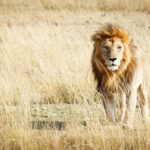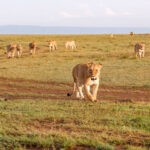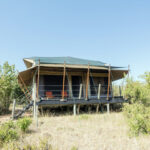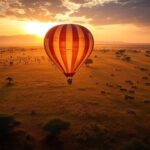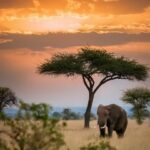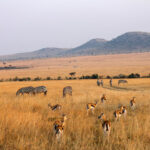Learn how to book the perfect safari with our detailed Mara Triangle Safari booking guide covering timing, costs, accommodations, and essential preparation tips.
Mara Triangle Safari Booking: A Step-by-Step Guide
Planning a safari to the Mara Triangle can feel overwhelming with so many options and logistics to consider. This exclusive conservancy offers some of Kenya’s most spectacular wildlife experiences, but proper booking ensures you get the most value from your investment while avoiding common pitfalls that can derail your dream safari.
The Mara Triangle’s conservancy model creates unique booking requirements compared to traditional national parks. Understanding these differences, along with optimal timing strategies and essential preparation steps, transforms your safari from a stressful gamble into a well-orchestrated adventure that delivers unforgettable memories.
Whether you’re a first-time safari visitor or returning to explore this incredible ecosystem, this comprehensive guide walks you through every booking step to secure the perfect Mara Triangle experience for your group, budget, and travel dates.
Mara Triangle Safari Booking
Step 1: Choose Your Optimal Travel Dates
Timing your Mara Triangle safari significantly impacts both your experience and costs. Different seasons offer distinct advantages, and understanding these patterns helps you make informed decisions about when to visit.
Great Migration Season (July-October)
Peak migration season delivers the most dramatic wildlife experiences, with millions of wildebeest and zebras crossing the Mara River in spectacular displays of survival. However, this period commands premium pricing and requires booking 6-12 months in advance.
River crossings occur unpredictably based on weather, predator pressure, and herd dynamics. Booking 4-5 nights during migration season increases your chances of witnessing these incredible events while allowing flexibility for weather delays.
Consider your tolerance for crowds when planning migration visits. Popular viewing areas become congested during peak crossing periods, though the conservancy’s limited vehicle numbers still provide better experiences than the main Masai Mara Reserve.
Shoulder Seasons Offer Excellent Value
May-June and November-December provide outstanding wildlife viewing with significantly reduced costs and fewer tourists. Many animals remain in the area year-round, creating excellent game viewing opportunities without migration crowds.
Weather becomes less predictable during shoulder seasons, with increased rainfall that can impact road conditions and outdoor activities. Build flexibility into your itinerary to accommodate weather-related changes.
Accommodation rates drop 30-50% during shoulder seasons while maintaining full service levels and activity availability. This timing works perfectly for budget-conscious travelers seeking premium experiences at reduced costs.
Dry Season Advantages (January-March)
Clear skies and minimal rainfall create ideal safari conditions during the dry season, though wildlife distributions shift as animals follow available water sources. Photography conditions remain excellent with bright, consistent lighting.
Temperature peaks occur during this period, requiring adequate sun protection and hydration planning. Early morning and late afternoon game drives become essential for comfortable wildlife viewing.
Vegetation dies back during dry periods, improving animal visibility and creating better photographic opportunities. Predator hunting success rates increase as prey animals concentrate around limited water sources.
Step 2: Determine Your Budget Range
Safari costs vary dramatically based on accommodation choices, activity preferences, and group size. Establishing a realistic budget guides decision-making throughout the booking process while preventing costly surprises.
Accommodation Cost Categories
Budget camping options start around $50-100 per person per night, including basic amenities and conservancy fees. These options require self-sufficiency but provide authentic bush experiences at accessible prices.
Mid-range lodges typically cost $200-400 per person per night with full board, game drives, and standard amenities. These properties balance comfort with value while providing professional guide services.
Luxury camps and lodges range from $500-1,500+ per person per night, offering premium accommodations, exclusive experiences, and exceptional service levels. Ultra-luxury properties justify premium pricing through unmatched locations and personalized attention.
Activity and Service Costs
Game drives are typically included in accommodation packages, but specialized activities like hot air balloon safaris cost $400-600 per person. Cultural visits and guided walks usually range from $50-150 per person depending on duration and complexity.
Private vehicle hire for self-drive safaris costs $100-200 per day plus fuel and conservancy fees. This option provides maximum flexibility but requires camping equipment and wilderness experience.
Professional guide services for walking safaris or specialized wildlife tracking typically cost $100-200 per day. These services significantly enhance wildlife encounter success and educational value.
Step 3: Research and Select Accommodations
Accommodation choice shapes your entire safari experience, from daily routines to wildlife viewing opportunities. The Mara Triangle offers diverse options catering to different preferences and budgets.
Location Considerations
Riverside properties provide front-row access to migration crossings and year-round water-dependent wildlife. These locations offer convenience but may experience higher noise levels from hippo populations and increased animal traffic.
Elevated positions on the Siria Escarpment offer panoramic views and unique photographic opportunities while providing natural cooling from elevation. Access may require longer drives to prime game viewing areas.
Central conservancy locations minimize travel time to diverse habitats while providing easy access to park gates and emergency services. These positions offer flexibility for various activity preferences.
Amenity and Service Levels
All-inclusive packages typically provide the best value for multiple-day stays, covering accommodation, meals, game drives, and conservancy fees. These packages eliminate daily cost uncertainties while ensuring comprehensive service.
Self-catering options work well for extended stays or groups with dietary restrictions, but require significant planning and food procurement in remote locations. Limited shopping opportunities make advance planning essential.
Family-friendly properties provide specialized services including children’s programs, appropriate safety measures, and family accommodation configurations. These properties often offer flexible activity scheduling to accommodate different age groups.
Booking Channels and Timing
Direct booking with accommodations often provides the best rates and flexibility for changes or special requests. Property websites offer detailed information about amenities, policies, and current availability.
Tour operator packages may include additional services like airport transfers, multi-destination itineraries, and emergency support. Compare total package costs against individual booking expenses to determine value.
Last-minute bookings occasionally offer significant discounts during slower periods, but risk accommodation unavailability during peak seasons. This strategy works only for flexible travelers with alternative plans.
Step 4: Understand Park Fees and Entry Requirements
The Mara Triangle operates a comprehensive fee structure that supports conservation efforts and community development. Understanding these costs ensures proper budgeting and legal compliance.
Conservancy Fee Structure
Daily conservancy fees vary based on nationality, with different rates for Kenyan residents, East African residents, and international visitors. Current fees change annually, so verify exact amounts before finalizing bookings.
Vehicle entry fees apply to all motorized transport entering the conservancy, charged per vehicle per day. These fees are separate from per-person conservancy charges and camping or accommodation costs.
Group discounts may apply for extended stays or larger parties, making longer trips more economical per person. Ask about available discounts when making reservations to maximize value.
Payment Methods and Documentation
Cash payments remain the primary method at park gates, though some accommodations can arrange advance payment on your behalf. Bring sufficient Kenyan shillings or US dollars for all fees and tips.
Credit card facilities are limited within the conservancy, so plan accordingly for all expenses including guide tips, cultural visit fees, and emergency purchases. ATM access is available in nearby towns but unreliable.
Valid identification is required for all visitors, with passports necessary for international travelers and national IDs acceptable for Kenyan residents. Keep multiple copies of important documents in separate locations.
Step 5: Book Essential Activities and Experiences
The Mara Triangle offers unique activities unavailable in many other safari destinations. Booking popular experiences in advance ensures availability while allowing optimal scheduling.
Hot Air Balloon Safaris
Balloon companies require advance bookings, especially during peak season when flights sell out weeks ahead. Early morning flights provide the best weather conditions and wildlife viewing opportunities.
Weight restrictions and weather dependencies mean balloon operators may cancel flights with short notice. Book early in your stay to allow rescheduling opportunities if initial flights are cancelled.
Champagne breakfast celebrations following balloon flights are included in most packages, creating memorable conclusion to your aerial adventure. Dietary restrictions should be communicated during booking.
Walking Safaris and Cultural Experiences
Walking safaris require advance arrangement with licensed guides and appropriate insurance coverage. These experiences provide intimate wildlife encounters impossible during vehicle-based game drives.
Cultural visits to Maasai communities need coordination with local leaders and may have specific timing requirements based on community schedules. Authentic cultural experiences require respectful engagement and appropriate compensation.
Photography workshops and specialized wildlife tracking experiences typically require minimum group sizes and advance booking. These services enhance safari educational value while providing professional instruction.
Specialized Transportation
Helicopter transfers and charter flights offer time-saving alternatives to road transport while providing aerial perspectives of the conservancy. These services require advance booking and weather contingency planning.
Boat excursions along the Mara River provide unique wildlife viewing angles and access to areas unreachable by vehicle. Water levels affect availability, making advance booking and flexible scheduling important.
Self-drive vehicle rental requires international driving permits for foreign visitors and comprehensive insurance coverage. Vehicle breakdowns in remote areas can be dangerous, making mechanical reliability crucial.
Step 6: Prepare Travel Documents and Requirements
Proper documentation prevents entry delays and ensures smooth transitions throughout your safari journey. Kenya’s requirements change periodically, so verify current regulations before departure.
Visa and Entry Requirements
Most international visitors require visas for Kenya entry, available online through the eVisa system or upon arrival at major airports. Processing times vary, so apply well in advance of travel dates.
Yellow fever vaccination certificates are required for travelers arriving from yellow fever risk areas. Even if not required, yellow fever vaccination is recommended for all safari travelers due to mosquito exposure risks.
Passport validity must extend at least six months beyond your planned departure date from Kenya. Ensure adequate blank pages for entry/exit stamps and any additional visas for multi-country trips.
Health and Safety Preparations
Malaria prophylaxis is strongly recommended for all Mara Triangle visitors due to significant mosquito populations and disease transmission risks. Consult travel medicine specialists 4-6 weeks before departure.
Comprehensive travel insurance should cover medical evacuation, trip cancellation, and adventure activity coverage. Standard policies often exclude safari activities, making specialized coverage necessary.
Emergency contact information should be shared with reliable contacts who can coordinate rescue operations if needed. Include park ranger contacts, accommodation details, and embassy information.
Photography and Equipment Considerations
Camera equipment protection from dust, moisture, and temperature extremes requires appropriate cases and cleaning supplies. Backup equipment prevents missed opportunities from mechanical failures.
Extra batteries and charging solutions are essential due to limited electrical access in remote areas. Solar chargers and portable power banks provide reliable backup power for extended trips.
Lens insurance and customs documentation for expensive equipment prevents complications during international travel. Register valuable items with customs authorities to facilitate return journeys.
Step 7: Finalize Logistics and Support Services
Comprehensive planning addresses transportation, communication, and emergency preparedness to ensure smooth safari execution from departure to return.
Transportation Arrangements
Airport transfers from Nairobi require advance arrangement unless included in accommodation packages. Road transfers take 4-6 hours while charter flights reduce travel time to 45 minutes.
Rental car arrangements for self-drive safaris should include comprehensive insurance, GPS navigation, emergency communication equipment, and detailed route planning with backup options.
Charter flight schedules depend on weather conditions and may face delays or cancellations. Build flexibility into tight itineraries to accommodate transportation disruptions.
Communication and Emergency Planning
Satellite communication devices provide emergency contact capabilities in areas without cellular coverage. Rental options are available through specialized operators or safari equipment suppliers.
Emergency evacuation insurance becomes crucial for serious medical situations requiring helicopter or fixed-wing aircraft transport to appropriate medical facilities. Verify coverage limits and activation procedures.
Detailed itinerary sharing with reliable contacts enables search and rescue operations if you fail to check in as scheduled. Include GPS coordinates, planned routes, and emergency contact information.
Local Services and Support
Professional guide services enhance wildlife viewing success while providing educational components about ecosystem relationships and conservation challenges. Guide quality varies significantly, so research options carefully.
Equipment rental for specialized items like camping gear, photography equipment, or communications devices saves luggage space while ensuring appropriate specifications for local conditions.
Currency exchange and banking services are limited within the conservancy, so arrange adequate local currency before arrival. US dollars are widely accepted but change may be given in Kenyan shillings.
First-Time Visitor Tips for Success
Safari rookies benefit from understanding common challenges and preparation strategies that experienced travelers take for granted. These insights prevent disappointment while maximizing enjoyment.
Realistic Expectation Setting
Wildlife viewing success varies unpredictably based on animal behavior, weather conditions, and seasonal movements. No safari guarantees specific animal sightings, making realistic expectations crucial for satisfaction.
Photography expectations should account for challenging lighting conditions, distant subjects, and fast-moving situations. Practice with equipment before departure to maximize success during limited opportunities.
Physical demands of safari activities may exceed expectations, especially for walking safaris or extended game drives over rough terrain. Physical preparation improves comfort and participation levels.
Packing and Preparation Strategies
Neutral-colored clothing reduces wildlife disturbance while providing better photographic backgrounds. Avoid bright colors, white clothing, and camouflage patterns that may cause problems with authorities.
Layered clothing systems accommodate dramatic temperature changes from early morning cold to midday heat. Quality outer layers protect from wind, rain, and sun exposure during extended outdoor periods.
Essential medication should include backup supplies stored in separate locations. Medical facilities are distant from most safari areas, making comprehensive first aid preparation important.
Cultural Sensitivity and Etiquette
Respectful interaction with local communities requires understanding of cultural norms and appropriate behavior. Learn basic greetings and cultural protocols before engaging with Maasai communities.
Photography permissions should be obtained before taking pictures of people, cultural ceremonies, or private property. Appropriate compensation may be expected for cultural demonstrations or portrait photography.
Environmental responsibility includes proper waste disposal, noise control, and wildlife interaction guidelines that protect both animals and visitors. Follow all guide instructions regarding appropriate behavior.
Peak Season Booking Strategies
Migration season demand requires advanced planning and flexible strategies to secure preferred accommodations and experiences during the most popular travel periods.
Timing Your Reservations
Begin researching options 12-18 months before intended travel dates during peak migration season. Popular accommodations and activities book solid during prime viewing periods.
Flexibility with exact dates provides more options during heavily booked periods. Consider extending stays to include shoulder season dates when availability improves and costs decrease.
Waitlist strategies may secure preferred accommodations if cancellations occur. Maintain backup options while pursuing primary choices to ensure successful safari completion.
Alternative Strategies for Popular Periods
Shoulder season timing around migration periods can provide excellent wildlife viewing with reduced crowds and costs. Animals often arrive early or stay late, extending viewing opportunities beyond peak periods.
Mid-week arrivals typically offer better availability and sometimes reduced rates compared to weekend arrivals during peak season. Flight scheduling may limit this flexibility but is worth exploring.
Group booking coordination can secure better rates and availability through block reservations, especially for larger parties or special celebrations requiring multiple accommodations.
Your Mara Triangle safari represents a significant investment in time, money, and expectations. Proper booking ensures this investment delivers maximum return through unforgettable experiences that connect you with one of Africa’s most important conservation success stories.
The step-by-step approach outlined in this guide eliminates guesswork while providing flexibility to customize your safari based on personal preferences and circumstances. Remember that your visit directly supports conservation efforts and local communities, making proper planning an investment in the long-term protection of this incredible ecosystem.
Take time to research thoroughly, book early during peak periods, and maintain realistic expectations about wildlife viewing. The Mara Triangle rewards careful planning with experiences that exceed expectations and create lifelong conservation awareness that extends far beyond your safari adventure.


